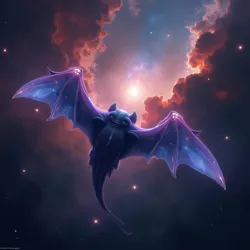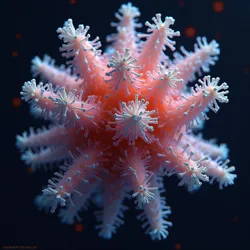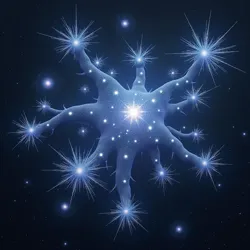Interstellar Xenobiological Survey: Common Void-Dwelling Life Forms
 A Void Manta (Spatiovora giganticus) gliding through the Carina Nebula, captured by the James Webb Space Telescope in 2024
A Void Manta (Spatiovora giganticus) gliding through the Carina Nebula, captured by the James Webb Space Telescope in 2024Recent discoveries have revolutionized our understanding of life beyond planetary boundaries, revealing a rich ecosystem of organisms that have evolved to thrive in the seemingly inhospitable conditions of interstellar space. This comprehensive survey documents the most frequently encountered species, their biological adaptations, and their ecological roles in the cosmic web of life.
Void-Dwelling Megafauna
The discovery of the Void Manta (Spatiovora giganticus) in 2021 marked a turning point in xenobiology, demonstrating that complex multicellular organisms could evolve to survive in the vacuum of space. These majestic creatures, spanning up to 300 kilometers in length, generate their own magnetic fields that shield them from harmful radiation while allowing them to harvest energy from stellar winds. Their translucent bodies, composed primarily of metallic hydrogen and exotic matter, can withstand extreme temperature variations and cosmic radiation.
The Stellar Medusoids represent another remarkable family of space-dwelling organisms, characterized by their ability to manipulate gravitational fields for both propulsion and feeding. These creatures bear a superficial resemblance to Earth's jellyfish but operate on fundamentally different biological principles. Their bell-shaped bodies contain complex networks of gravitational synthesis organs that allow them to extract energy and matter directly from the fabric of spacetime.
Microscopic Life Forms
The most abundant life forms in interstellar space are microscopic organisms collectively known as cosmophytes. These hardy microorganisms can be found in dense clouds throughout the galaxy, often forming vast colonies that span several light-years. Recent studies have shown that cosmophytes play a crucial role in the formation of complex organic molecules in space, contributing to the chemical evolution of the galaxy.
 False-color electron microscope image of cosmophyte colonies collected from the Horsehead Nebula
False-color electron microscope image of cosmophyte colonies collected from the Horsehead NebulaVacuum Extremophiles represent a diverse group of single-celled organisms that have evolved sophisticated mechanisms for surviving in the harsh conditions of space. These remarkable life forms can enter a state of cryptobiosis when exposed to extreme conditions, allowing them to survive for thousands of years while drifting between stars. Some species have developed the ability to use cosmic rays as an energy source, while others metabolize the rare atoms found in the interstellar medium.
Collective Organisms and Living Networks
Perhaps the most enigmatic of all space-dwelling life forms are the Stellar Mycelia, vast networks of energy-conducting filaments that can span entire star systems. These living networks share some characteristics with fungal mycelia on Earth but operate on an incomprehensibly larger scale. Stellar Mycelia appear to facilitate energy and information exchange between different regions of space, leading some researchers to propose that they form a kind of galactic nervous system.
The discovery of Nebular Collectives has challenged our very definition of life. These loosely organized assemblages of particles and energy fields exhibit complex emergent behaviors that suggest some form of collective intelligence. Observed primarily in emission nebulae, these entities appear to coordinate their activities across vast distances through mechanisms that remain poorly understood.
Ecological Interactions
The interstellar ecosystem is characterized by complex relationships between different species, many of which defy traditional ecological classifications. Void Symbiosis is particularly common, with smaller organisms often forming mutually beneficial relationships with larger space-dwelling creatures. For example, colonies of cosmophytes frequently inhabit the magnetic field lines of Void Mantas, gaining protection while helping to maintain the larger organism's electromagnetic balance.
Impact on Human Space Travel
The presence of space-dwelling life forms has significant implications for interstellar travel and exploration. While most of these organisms are harmless to spacecraft, some species can pose serious risks. The Navigation Safety Protocol established by the International Space Agency includes detailed guidelines for avoiding dangerous concentrations of space-dwelling organisms and managing encounters with potentially hazardous species.
Research Methodology
Studying life in interstellar space presents unique challenges that have driven the development of novel research techniques. The Xenobiological Observation Network combines data from thousands of automated probes, space telescopes, and research stations throughout known space. Advanced spectral analysis methods allow researchers to detect and classify space-dwelling organisms based on their energy signatures and molecular compositions.
Conservation Concerns
As human activity in space increases, concerns have emerged about the preservation of these unique ecosystems. The Interstellar Conservation Initiative works to protect important habitats and monitor the impact of space traffic on void-dwelling species. Of particular concern are the effects of antimatter drive emissions on sensitive organisms and the potential disruption of Stellar Mycelia networks by frequent faster-than-light travel.
Current Areas of Research
Modern xenobiological research focuses on several key areas:
-
Understanding the origin and evolution of space-dwelling life forms
-
Mapping the distribution and migration patterns of void-dwelling species
-
Investigating potential applications of space-dwelling organisms in biotechnology and space exploration
 Stellar Mycelium network observed in the Pleiades star cluster, showing characteristic bioluminescent patterns
Stellar Mycelium network observed in the Pleiades star cluster, showing characteristic bioluminescent patternsScientists continue to make new discoveries about interstellar life forms, challenging our understanding of what constitutes life and how it can adapt to extreme environments. The field of xenobiology remains one of the most dynamic and rapidly evolving areas of scientific research, with new species and phenomena being documented regularly. As our exploration of space continues, we can expect to encounter even more remarkable examples of life's ability to thrive in the most challenging environments imaginable.
Recent breakthroughs in Xenobiological Observation Technology have opened up new avenues for research, allowing scientists to study these fascinating organisms in unprecedented detail. The development of specialized instruments capable of detecting and analyzing the unique energy signatures of space-dwelling life forms has revolutionized our ability to understand their biology and behavior.
The future of interstellar xenobiology holds great promise, with potential applications ranging from space habitat design to advanced propulsion systems inspired by void-dwelling organisms. As we continue to explore the cosmos, our understanding of life beyond Earth will undoubtedly continue to expand, revealing new wonders and challenging our preconceptions about the nature of life itself.